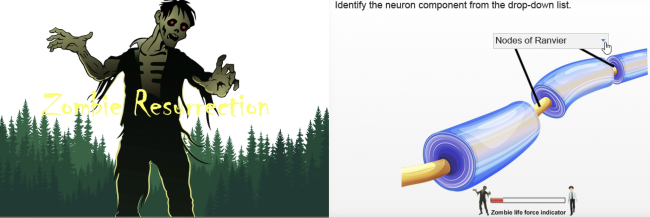You have /5 articles left.
Sign up for a free account or log in.

Introductory psychology students at Brookdale Community College who completed a nervous system science–based game called Zombie Resurrection ended up scoring an average of 10 points higher on their corresponding unit assessments than peers who didn’t.
Jonathan Shaloum/Brookdale Community College
Problem: introductory psychology students are struggling to learn basic neuroscience concepts.
Solution: create a zombie-themed game in which students must apply their knowledge of brain, neuron and nervous system parts, processes and functions to reanimate the undead (and save humanity).
That’s what one professor at Brookdale Community College in New Jersey did with the help of his Teaching and Learning Center. And it’s not just fun and games: students who completed the digital interactive, called Zombie Resurrection, ended up scoring an average of 10 points higher on their unit exam than peers who didn’t. That closed the gap between students’ performance on this unit versus others in the course.
What’s the need: What prompted this zombie apocalypse at Brookdale? Eugene M. DeRobertis, professor of psychology, was thinking a lot about formal assessment when he became department chair a decade ago. So he dived into a research project on learning outcomes for majors, collecting course materials and grade rosters from fellow professors and cross-referencing the documents to see which assessments were proving trickiest for students.
Again and again, DeRobertis noticed that students across the department were struggling early in the first semester of a two-part introductory psychology course sequence. Digging deeper, DeRobertis realized students weren’t grasping neurologically oriented items, what he calls the “ground level” of brain science. He needed an instructional intervention, for which he had two requirements: it had to make neurons and neurological system hierarchy somehow “relatable” to students, and students couldn’t be “passive” participants.
How it works: At the time, public interest in the zombie apocalypse–set television show The Walking Dead was at its peak. So DeRobertis, a fan of the show and the horror genre in general, asked his Teaching and Learning Center director to help him create a zombie-themed online game rooted in brain science.
“Maybe we can create a scenario where students are forced to develop baseline knowledge of the different parts and functions, but cloak the whole thing in a cinematic or theatrical thread,” DeRobertis recalls his proposal. “The narrative would be that they’re doing this because they have to save the human race. They’d have to be able to reanimate the totality of the nervous system, beyond vegetative functioning.”
Soon DeRobertis had his game—and data to prove Zombie Resurrection was working.
What’s new: A decade later, DeRobertis is still using the interactive, and he says it’s especially popular with fall classes, when students complete it around Halloween. Other professors in psychology and nursing have opted to use the game with their students, as well.
DeRobertis is also working with the Teaching and Learning Center to update Zombie Resurrection, now in its second iteration. The main difference between the first and second versions is that students are now required to complete modules before moving ahead in the game, to promote mastery of individual concepts, he says. A “zombie life force indicator” bar at the bottom of the screen shows students’ progress.
Zombie Resurrection 3.0, a more conceptually advanced version of the game, is planned for release later this year. DeRobertis has even created two additional interactives to help students grasp additional abstract psychology concepts, including one game with a superhero narrative (a self-described nerd, he attributes that idea to the popularity of the Marvel cinematic universe).
Why zombies make a difference: Jonathan Shaloum, director of teaching and learning at Brookdale, says his center produces custom interactive multimedia for faculty members to support student learning in a cost-effective way.
“Animation is effective in explaining processes that are otherwise unobservable,” he explains. “Processes may move too quickly or slowly, they may be too large or too small, or they may be unsafe to observe in person.”
Zombie Resurrection, in particular, leverages animation to help students “identify the components and interworking of the human neuron and to explain the interdependencies of the human neurological system.” But it also goes “one step further by making students active participants in the animation series.”
Beyond being interactive, DeRobertis says, Zombie Resurrection meets some definitions of gamification and certainly builds on long-standing research on the importance of play in education.
“Creativity and learning are supposed to be intertwined all the way through education,” he says, though learning tends to become more “mechanical” as students advance through school, for a variety of reasons.
Interactives or games like Zombie Resurrection therefore help reanimate (pun intended) the learning process so that students are, in DeRobertis’s words, “getting baseline knowledge, but in a way that’s more robust and sets them up to move up to a more conceptual form of knowledge. The play dimension of it is activating creativity, imagination.”
Tell us how you’ve used play or games to help students grasp challenging concepts.





